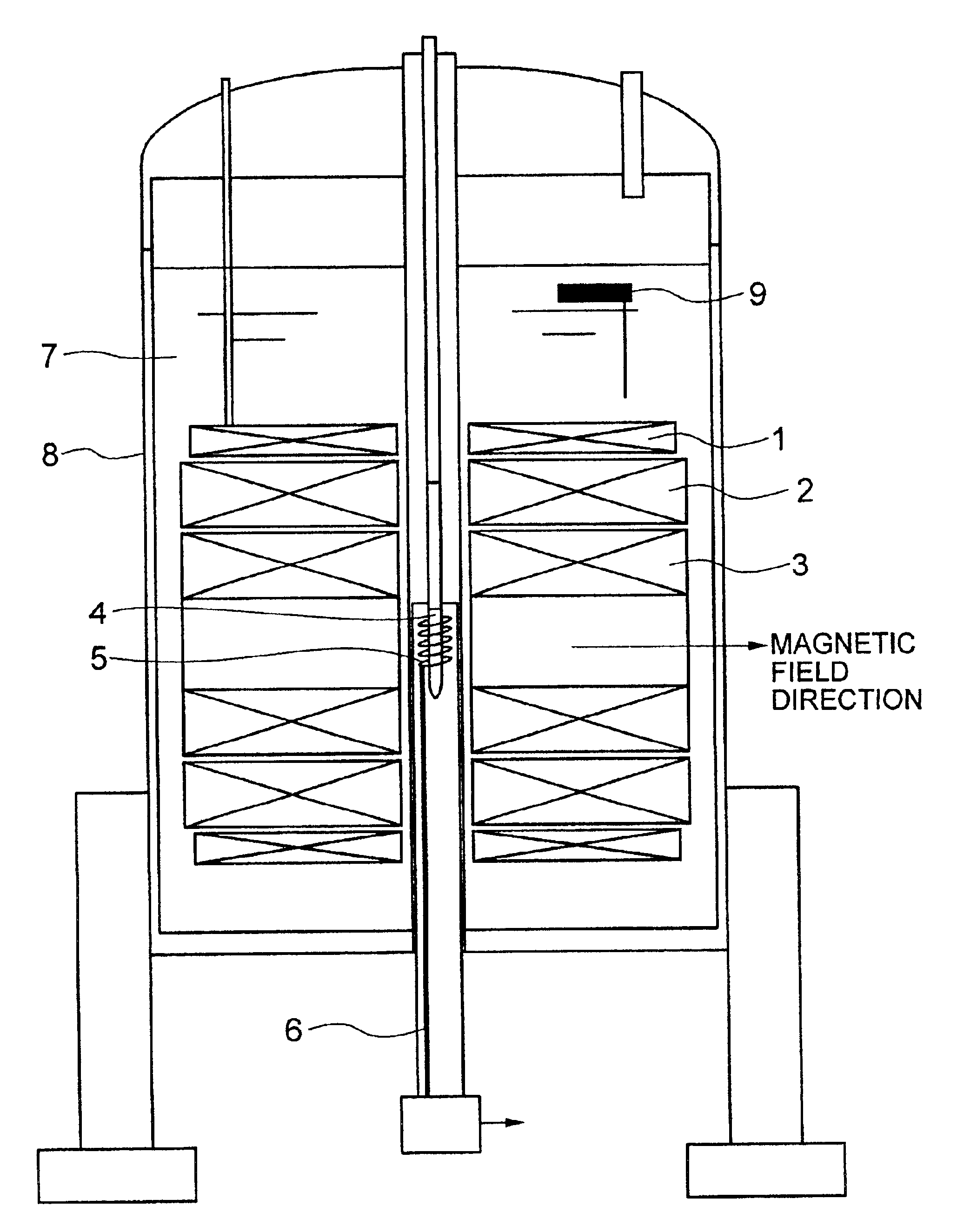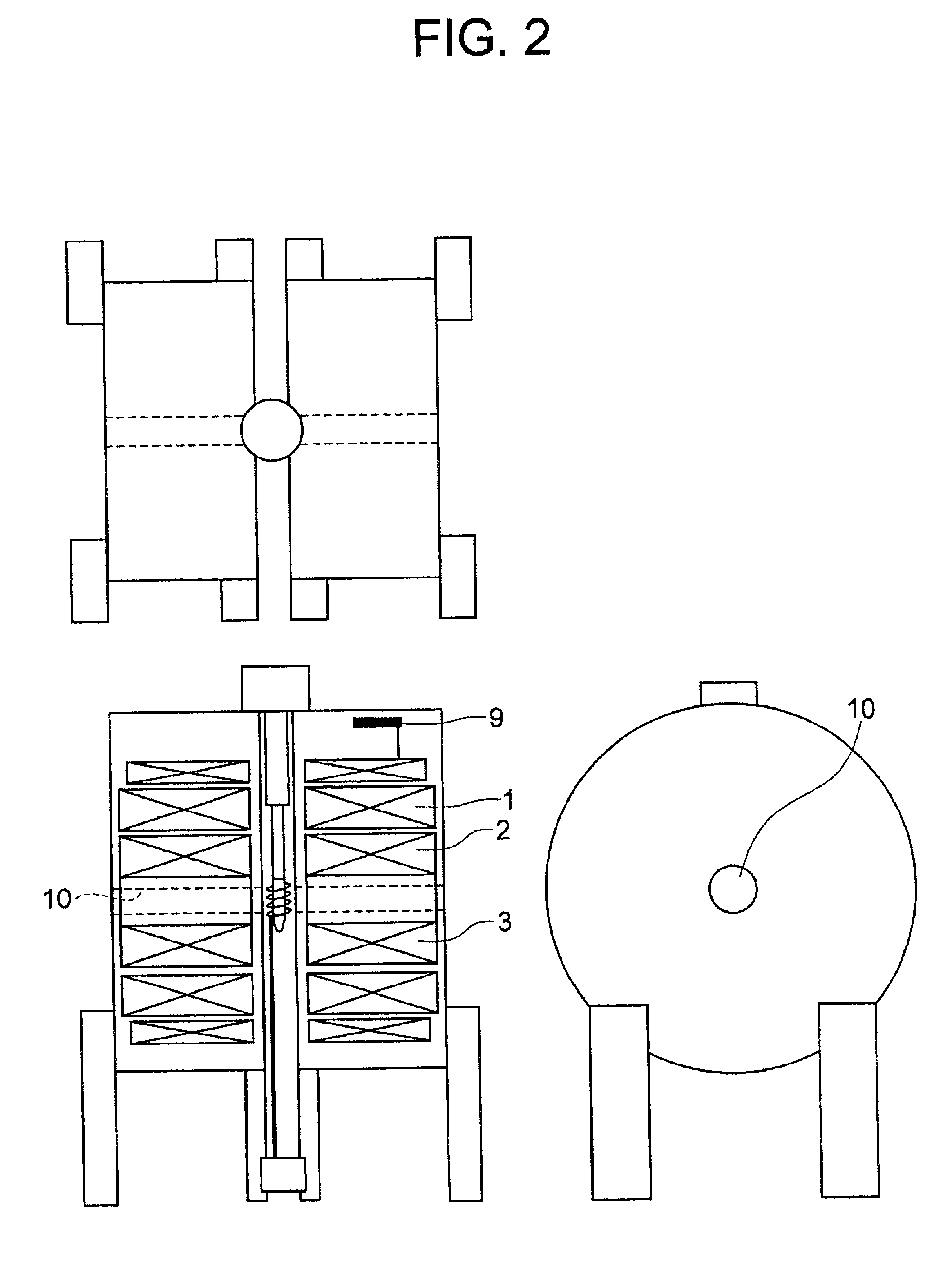Nuclear magnetic resonance spectrometer for liquid-solution
a spectrometer and nuclear magnetic resonance technology, applied in the field of nuclear magnetic resonance spectrometers, can solve the problems of difficult design, no example of constructing a general-purpose liquid-solution protein analysis nmr spectrometer using split magnets, etc., and achieve the effect of improving sensitivity and measuring sensitivity of nmr signals
- Summary
- Abstract
- Description
- Claims
- Application Information
AI Technical Summary
Benefits of technology
Problems solved by technology
Method used
Image
Examples
embodiment 1
(Embodiment 1)
[0038]A first embodiment of the present invention is shown in FIG. 1. Of superconductive magents 1, 2 and 3, an inner one closer to a sample has a coil made of a material of higher superconductivity critical magnetic field. For example, coils of the superconductive magnets 1, 2 and 3 are made of Nb3Al, Nb3Sn and NbTi, respectively, but as necessary, they may optimally be combined with each other to provide a desired value of a magnetic field generated by the coils and a desired value of uniformity. As an example, either a superconductive material of a Bi system such as Bi2Sr2CaCu2O9 or of a Y1Ba2Cu3O7 or MgB2 may be used. The superconductive magnets having the coils combined as above generate a magnetic field in the horizontal direction. In FIG. 1, a protein sample 4 dissolved in an aqueous solution is charged in a sample tube up to a height of 30 mm, the sample tube having a diameter of 5 to 10 mm and being made of glass possessing magnetic properties equivalent to th...
embodiment 2
(Embodiment 2)
[0042]A second embodiment of the invention is shown in FIG. 2. Structurally, the present embodiment is substantially the same as the first embodiment but the low temperature container is divided in correspondence with the left and right divisions of superconductive magnet to make the user's space utilization releasable. Namely, in contrast to the conventional hermetical sample space, there is an open space around the sample chamber and therefore, dynamic behavior of protein can be measured by, for example, irradiating light or laser rays on the sample. Since a dynamic NMR signal as above can be observed, signal transmission or photosynthesis of protein, for instance, can be examined. In the case of a special experiment as above, by cooling the superconductive magnet through pumping of liquid helium to operate it at 1.8 k, the apparatus can be operated at a center magnetic field of about 900 MHz (21.1 T). The detection sensitivity in this case is comparable to that in N...
embodiment 3
(Embodiment 3)
[0043]A third embodiment of the invention is shown in FIG. 3. Structurally, in the present embodiment, 8 pairs of superconductive magents 11 are arranged toroidally in the horizontal direction with a view to reducing the leakage magnetic field and enhancing the integration or intensiveness of apparatus. More particularly, 8 NMR spectrometers are juxtaposed in a single low-temperature container cooled with liquid helium. Each of the 8 pairs of split magnets can be constructed as detailed in connection with the first embodiment to generate, for example, about 600 MHz. Preferably, however, the frequency referenced to 600 MHz may be changed by 10 Hz between adjacent NMR spectrometers. For example, 610 MHz, 620 MHz, 630 MHz and so on are available. This is advantageous in that even for the same sample 12, NMR signals of the different spectrometers can advantageously be discriminated from each other. With this construction, since the intensiveness of the NMR spectrometers hi...
PUM
| Property | Measurement | Unit |
|---|---|---|
| nuclear magnetic resonance frequency | aaaaa | aaaaa |
| diameter | aaaaa | aaaaa |
| magnetic resonance frequency | aaaaa | aaaaa |
Abstract
Description
Claims
Application Information
 Login to View More
Login to View More - R&D
- Intellectual Property
- Life Sciences
- Materials
- Tech Scout
- Unparalleled Data Quality
- Higher Quality Content
- 60% Fewer Hallucinations
Browse by: Latest US Patents, China's latest patents, Technical Efficacy Thesaurus, Application Domain, Technology Topic, Popular Technical Reports.
© 2025 PatSnap. All rights reserved.Legal|Privacy policy|Modern Slavery Act Transparency Statement|Sitemap|About US| Contact US: help@patsnap.com



